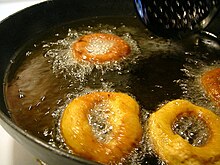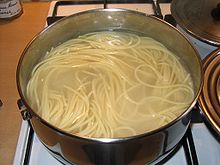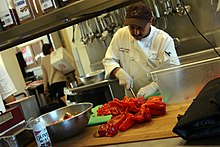వంట: కూర్పుల మధ్య తేడాలు
| పంక్తి 23: | పంక్తి 23: | ||
==Ingredients== |
==Ingredients== |
||
{{unreferenced section|date=March 2017}} |
|||
Most ingredients in cooking are derived from [[organism|living organisms]]. Vegetables, fruits, grains and nuts as well as herbs and spices come from plants, while meat, eggs, and dairy products come from animals. Mushrooms and the yeast used in baking are kinds of [[Fungus|fungi]]. Cooks also use [[water]] and [[mineral]]s such as [[salt]]. Cooks can also use [[wine]] or [[Distilled beverage|spirits]]. |
Most ingredients in cooking are derived from [[organism|living organisms]]. Vegetables, fruits, grains and nuts as well as herbs and spices come from plants, while meat, eggs, and dairy products come from animals. Mushrooms and the yeast used in baking are kinds of [[Fungus|fungi]]. Cooks also use [[water]] and [[mineral]]s such as [[salt]]. Cooks can also use [[wine]] or [[Distilled beverage|spirits]]. |
||
15:38, 21 అక్టోబరు 2020 నాటి కూర్పు

వంట లేదా కుకరీ అంటే సాంకేతికత, శాస్త్రం, చేతినైపుణ్యంతో వేడిని ఉపయోగించి ఆహారాన్ని సిద్ధం చేసే కళ. వంటచేసే పద్ధతులు, పదార్థాల చేరిక ప్రపంచవ్యాప్తంగా విస్తృతంగా మారుతుంటాయి. వంట తయారీలో ఆహారాన్ని నిప్పు మీద వేయడం, విద్యుత్ పొయ్యిలను ఉపయోగించడం, వివిధ రకాల ఓవెన్లలో కాల్చడం వంటి ప్రత్యేకమైన పర్యావరణ, ఆర్థిక, సాంస్కృతిక సంప్రదాయాల పోకడలు ప్రతిబింబిస్తాయి.
వంట రకాలు కూడా వంటచేసేవారి నైపుణ్యం స్థాయిలు, శిక్షణమీద, ఆధారపడి ఉంటాయి. స్వంత నివాసాలలో, రెస్టారెంట్లు, ఇతర ఆహార సంస్థలలో వృత్తిపరమైన వంటమనుషులు, పాకశాస్త్రనిపుణుల చేత చేయబడుతుంది. రసాయన ప్రతిచర్యల ద్వారా వేడిచేయకుండానే వంట సంభవిస్తుంది. ఉదాహరణకు సెవిచే అనే దక్షిణ అమెరికా సంప్రదాయ వంటకంలో చేపలను నిమ్మరసం లేదా నారింజ రసంలో ఉండే ఆమ్లాలతో వండుతారు.
వేడి లేదా అగ్నితో ఆహారాన్ని సిద్ధం చేయడం మానవులకు మాత్రమే ప్రత్యేకమైన చర్య. ఇది సుమారు 2 మిలియన్ సంవత్సరాల క్రితం ప్రారంభమై ఉండవచ్చని భావిస్తున్నారు. అయితే ఇప్పటి వరకు దీనికి అవసరమైన 1 మిలియన్ సంవత్సరాల కంటే మునుపటి పురావస్తు ఆధారాలు లభించలేదు.[1]
వివిధ ప్రాంతాలలో నాగరికతల మధ్య వ్యవసాయం, వాణిజ్యం, వాణిజ్యం, రవాణా విస్తరణ పాకశాస్త్రనిపుణులకు అనేక కొత్త పదార్ధాలను అందించింది. నీటిని నిలువచేసుకోవడం, మరిగించడం కోసం కుండల ఆవిష్కరణ, విస్తరించిన వంట పద్ధతులు వంటి కొత్త ఆవిష్కరణలు, సాంకేతికతలు అభివృద్ధిచెందాయి. కొంతమంది ఆధునిక పాకశాస్త్రనిపుణులు వడ్డించిన వంటకం రుచిని మరింత పెంచడానికి ఆహార తయారీకి అధునాతన శాస్త్రీయ పద్ధతులను జతచేస్తున్నారు.[2]
ఆహారం తయారు చేసే ప్రక్రియను వంట చేయడం అంటారు. వంట తయారీకి ముఖ్యంగా వేడిని ఉపయోగిస్తారు. అందువలన ఆహారానికి సంబంధించిన పదార్ధాలను వేడిచేయడం ద్వారా అనగా వండడం ద్వారా తినడానికి తయారు చేసుకున్న అహార పదార్ధాలను వంటకాలు అని అంటారు. ప్రపంచ వ్యాప్తంగా వంట తయారీకి కావలసిన పదార్ధాలు, తయారు చేసే పద్ధతులు ప్రాంతాన్ని బట్టి మారుతూ ఉంటాయి. వంట పద్ధతులలో పర్యావరణ, ఆర్థిక, సాంస్కృతిక సంప్రదాయాలు ప్రతిబింబిస్తాయి. వంటమనుషులు అవసరానికి అనుగుణంగా మారుతూ విస్తృతంగా వారికి వారే శిక్షణ పొందుతూ వంట తయారీలో నైపుణ్యాన్ని సాధిస్తుంటారు
చరిత్ర
ఫైలోజెనెటిక్ విశ్లేషణ పూర్వీక మానవులు 1.8 మిలియన్ల - 2.3 మిలియన్ సంవత్సరాల క్రితం వంటను కనుగొన్నారని సూచిస్తుంది.[3] దక్షిణాఫ్రికాలోని వండర్వర్కు గుహ నుండి కాలిపోయిన ఎముక శకలాలు, మొక్కల బూడిద వంటి ఆధారాల పునఃవిశ్లేషణ 1 మిలియన్ సంవత్సరాల క్రితం ప్రారంభ మానవులు అగ్నిని నియంత్రించడానికి సూచనగా అందించబడ్డాయి.[4] హోమో ఎరెక్టస్ 5,00,000 సంవత్సరాల క్రితం వారి ఆహారాన్ని వండుకొన్నట్లు ఆధారాలు ఉన్నాయి.[5] హోమో ఎరెక్టస్ అగ్నిని నియంత్రించి ఉపయోగించడం 4,00,000 సంవత్సరాల క్రితం ప్రారంభం అయిందని పరిశోధకులు భావిస్తున్నారు.[6][7]3,00,000 సంవత్సరాల క్రితంనాటి పురావస్తు ఆధారాలు,[8] ఐరోపా, మధ్యప్రాచ్యాలలో పురాతన పొయ్యిలు, ఎర్త్ ఓవెన్లు, కాలిన జంతువుల ఎముకలు, చెకుముకి రూపంలో కనుగొనబడ్డాయి. 2,50,000 సంవత్సరాల క్రితం పొయ్యిలు మొదట కనిపించినప్పుడు విస్తృతంగా వంటలు ప్రారంభమయ్యాయని మానవ శాస్త్రవేత్తలు భావిస్తున్నారు.[9]
ఇటీవల లభించిన ఆరంభకాల పొయ్యిలకు కనీసం 7,90,000 సంవత్సరాల వయస్సు ఉన్నట్లు నిర్ధారించబడ్డాయి.[10]

పారిశ్రామిక విప్లవం సామూహిక ఉత్పత్తి, సామూహిక మార్కెటింగు ప్రామాణీకరణ చేయబడిన ఆహారవిధానాన్ని తీసుకువచ్చింది. కర్మాగారాలు ప్రాసెస్ చేయబడి సంరక్షించబడి, కేనులలో నిలువచేయబడి, తినడానికి తయారుగా ఉన్న వివిధరకాల రకాలైన ఆహారాన్ని ప్యాక్ చేసి అందుబాటులోకి తీసుకువచ్చాయి. ప్రాసెస్ చేసిన తృణధాన్యాలు అమెరికన్ అల్పాహారాలుగా ప్రాచుర్యం పొందాయి.[12] 1920 లలో శీతలీకరణ పద్ధతులు, ఫలహారశాలలు, ఫాస్ట్ ఫుడ్ రెస్టారెంట్లు ఉద్భవించాయి. 20 వ శతాబ్దం ప్రారంభంలో ప్రభుత్వాలు ఆహార పిరమిడు రూపంలో పోషకాహార మార్గదర్శకాలను జారీ చేశాయి.[13]
ఈ విధానాలు (1974 లో స్వీడన్లో ప్రవేశపెట్టబడింది). 1916 "ఫుడ్ ఫర్ యంగ్ చిల్డ్రన్" పేరుతో యుఎస్డిఎ గైడ్ మొదటి నిర్దిష్ట ఆహార మార్గదర్శకాలను ఇచ్చింది. 1920 లలో నవీకరించబడిన ఈ గైడ్లు వివిధ పరిమాణాల కుటుంబాలకు షాపింగ్ సూచనలు ఇచ్చాయి. ఈ మార్గదర్శకాలు డిప్రెషన్ ఎరా సమయంలో నాలుగు ఖర్చు స్థాయిల ఆహారప్రణాళికను అందించాయి. 1943 లో యుఎస్డిఎ పోషకాహార విధానం ప్రోత్సహించడానికి "బేసిక్ సెవెన్" చార్టును రూపొందించింది. ఇందులో నేషనల్ అకాడమీ ఆఫ్ సైన్సెస్ నుండి మొట్టమొదటిగా సిఫార్సు చేయబడిన డైలీ అలవెన్సులు ఉన్నాయి. 1956 లో "ఎస్సెన్షియల్స్ ఆఫ్ ఎ అడిక్వేటు డైట్" సిఫారసులను తీసుకువచ్చింది. 1979 లో "ఫుడ్" అనే గైడ్ అధిక మొత్తంలో అనారోగ్యకరమైన ఆహారాలు, దీర్ఘకాలిక వ్యాధుల మధ్య సంబంధాన్ని వివరించింది. నాలుగు ప్రాథమిక ఆహార సమూహాలకు కొవ్వులు, నూనెలు, స్వీట్లు చేర్చబడ్డాయి.
Ingredients
Most ingredients in cooking are derived from living organisms. Vegetables, fruits, grains and nuts as well as herbs and spices come from plants, while meat, eggs, and dairy products come from animals. Mushrooms and the yeast used in baking are kinds of fungi. Cooks also use water and minerals such as salt. Cooks can also use wine or spirits.
Naturally occurring ingredients contain various amounts of molecules called proteins, carbohydrates and fats. They also contain water and minerals. Cooking involves a manipulation of the chemical properties of these molecules.
Carbohydrates
Carbohydrates include the common sugar, sucrose (table sugar), a disaccharide, and such simple sugars as glucose (made by enzymatic splitting of sucrose) and fructose (from fruit), and starches from sources such as cereal flour, rice, arrowroot and potato.[14]
The interaction of heat and carbohydrate is complex. Long-chain sugars such as starch tend to break down into simpler sugars when cooked, while simple sugars can form syrups. If sugars are heated so that all water of crystallisation is driven off, then caramelization starts, with the sugar undergoing thermal decomposition with the formation of carbon, and other breakdown products producing caramel. Similarly, the heating of sugars and proteins elicits the Maillard reaction, a basic flavor-enhancing technique.
An emulsion of starch with fat or water can, when gently heated, provide thickening to the dish being cooked. In European cooking, a mixture of butter and flour called a roux is used to thicken liquids to make stews or sauces.[15] In Asian cooking, a similar effect is obtained from a mixture of rice or corn starch and water. These techniques rely on the properties of starches to create simpler mucilaginous saccharides during cooking, which causes the familiar thickening of sauces. This thickening will break down, however, under additional heat.
Fats

Types of fat include vegetable oils, animal products such as butter and lard, as well as fats from grains, including maize and flax oils. Fats are used in a number of ways in cooking and baking. To prepare stir fries, grilled cheese or pancakes, the pan or griddle is often coated with fat or oil. Fats are also used as an ingredient in baked goods such as cookies, cakes and pies. Fats can reach temperatures higher than the boiling point of water, and are often used to conduct high heat to other ingredients, such as in frying, deep frying or sautéing. Fats are used to add flavor to food (e.g., butter or bacon fat), prevent food from sticking to pans and create a desirable texture.
Proteins
Edible animal material, including muscle, offal, milk, eggs and egg whites, contains substantial amounts of protein. Almost all vegetable matter (in particular legumes and seeds) also includes proteins, although generally in smaller amounts. Mushrooms have high protein content. Any of these may be sources of essential amino acids. When proteins are heated they become denatured (unfolded) and change texture. In many cases, this causes the structure of the material to become softer or more friable – meat becomes cooked and is more friable and less flexible. In some cases, proteins can form more rigid structures, such as the coagulation of albumen in egg whites. The formation of a relatively rigid but flexible matrix from egg white provides an important component in baking cakes, and also underpins many desserts based on meringue.

Water
Cooking often involves water and water-based liquids. These can be added in order to immerse the substances being cooked (this is typically done with water, stock or wine). Alternatively, the foods themselves can release water. A favorite method of adding flavor to dishes is to save the liquid for use in other recipes. Liquids are so important to cooking that the name of the cooking method used is often based on how the liquid is combined with the food, as in steaming, simmering, boiling, braising and blanching. Heating liquid in an open container results in rapidly increased evaporation, which concentrates the remaining flavor and ingredients – this is a critical component of both stewing and sauce making.
Vitamins and minerals

Vitamins and minerals are required for normal metabolism but which the body cannot manufacture itself and which must therefore come from external sources. Vitamins come from several sources including fresh fruit and vegetables (Vitamin C), carrots, liver (Vitamin A), cereal bran, bread, liver (B vitamins), fish liver oil (Vitamin D) and fresh green vegetables (Vitamin K). Many minerals are also essential in small quantities including iron, calcium, magnesium, sodium chloride and sulfur; and in very small quantities copper, zinc and selenium. The micronutrients, minerals, and vitamins[16] in fruit and vegetables may be destroyed or eluted by cooking. Vitamin C is especially prone to oxidation during cooking and may be completely destroyed by protracted cooking.[17][ఆధారం యివ్వలేదు] The bioavailability of some vitamins such as thiamin, vitamin B6, niacin, folate, and carotenoids are increased with cooking by being freed from the food microstructure.[18] Blanching or steaming vegetables is a way of minimizing vitamin and mineral loss in cooking.
మళ్లీమళ్లీ వేడిచేయడం వల్ల ఆహారానికి జరిగే నష్టము
వండిన వాటినే రెండోసారి వేడి చేయడం చాలా ఇళ్లల్లో తప్పనిసరవుతోంది. వేపుళ్లకి వాడగా మిగిలిన నూనెను ఇతర పదార్థాల తయారీలో ఉపయోగించడం.. కూరలని, మాంసాహారాన్ని మళ్లీమళ్లీ వేడి చేయడం.. వంటివన్నీ ఆరోగ్యంపై ప్రభావం చూపుతాయని గుర్తించాలి. మళ్లీమళ్లీ వేడి చేయడము వల్ల గుండెకు చేటు. పండుగలప్పుడు, ఇంట్లో కార్యక్రమాలున్నప్పుడు పిండి వంటలు తప్పనిసరి. ఇందుకోసం పెద్ద కడాయి నిండా నూనె వేసి రకరకాల పదార్థాల్ని వేయిస్తాం. మిగిలిన నూనెను మళ్లీ వాడుతుంటాం. ఒకసారి నూనెని స్మోక్ పాయింట్ వరకు వేడిచేస్తే దానిలో రసాయన చర్య జరిగి స్వభావం మారుతుంది. మళ్లీ దానినే వేడిచేస్తే అందులో విషపదార్థాలు తయారవుతాయి. ఆ నూనెతో చేసిన పదార్థాల్ని తినడం వల్ల గుండెజబ్బులు, నరాల సంబంధ వ్యాధులు దాడిచేస్తాయి. ముఖ్యంగా రోడ్డువారన అమ్మే పదార్థాలు, రెస్టారంట్ ఆహారం పట్ల జాగ్రత్త అవసరం. స్వీట్లు, బజ్జీల వంటివి తినేటప్పుడు మరింత అప్రమత్తంగా ఉండాలి.
నూనెలను వేడి చేయకూడదు
- ఇంట్లో వాడే సోయా, వెజిటబుల్ నూనెల్ని మళ్లీమళ్లీ వేడి చేయకూడదు. నెయ్యి, డాల్డా, కొబ్బరినూనె, వేరు సెనగనూనె వంటివి (కొంతవరకు) వేడిచేసినా వాటి స్వభావం పెద్దగా మారదు. కానీ అవీ హానికరమే! అందుకని కావాల్సినంతే వాడాలి. చిన్న కడాయిలో వంటకాలు చేస్తే నూనె తక్కువ పడుతుంది. మిగలదు. అన్నాన్ని వేడి చేస్తున్నారా? వండిన అన్నం వండినట్టే ఉంది. పారేయలేం. పైగా బియ్యం బోలెడు ఖరీదంటూ తిరిగి అన్నాన్ని వేడిచేసే వారిని చూస్తుంటాం. అది తప్పేం కాకపోయినా.. అన్నాన్ని సరిగ్గా భద్రపరచకున్నా.. ఆ తరువాత సక్రమంగా వేడిచేయకపోయినా ఆరోగ్యానికి ప్రమాదమే. అన్నాన్ని కొన్ని గంటల పాటు బయటే ఉంచి.. ఆ తరువాత ఫ్రిజ్లో పెట్టి తినాలనుకున్నప్పుడు అరకొరగా వేడిచేయడం సరికాదు. బియ్యంలో కొన్నిసార్లు బ్యాక్టీరియా ఆవాసం ఉంటాయి. దాంతో అన్నాన్ని సరిగా వేడిచేయనప్పుడు వృద్ధిచెందుతాయి. అందుకే పూర్తిగా వేడిచేయాలి. అన్నంపై కాసిని నీళ్లు చల్లి కుక్కర్లో ఉంచి ఒక కూత రాగానే దించేయాలి. దాంతో బ్యాక్టీరియా వృద్ధి చెందదు. అలాగే వేడివేడిగా ఉన్నప్పుడే తినేయాలి. చల్లారాక తిందామనుకుంటే పోషకాలు అందవు. అనారోగ్యం కూడా.
మాంస కృత్తులు అధికంగా వుండే ఆహార పదార్థాలను మాటిమాటికి వేడి చేయవద్దు
పదేపదే వేడిచేస్తే... పోషకాలు అధికంగా ఉండే ఏ పదార్థాలయినా త్వరగా పాడవుతాయి. ముఖ్యంగా మాంసకృత్తులు అధికంగా ఉండే చికెన్, చేప, పాలు, పాల ఉత్పత్తులు, పచ్చి బఠాణీ, గుడ్డు.. వంటివాటి విషయంలో జాగ్రత్తగా ఉండాలి. చికెన్లో సాల్మొనెల్లా బ్యాక్టీరియా త్వరగా వృద్ధి చెందుతుంది. వండిన తర్వాత రెండు గంటలకన్నా ఎక్కువ సేపు ఆ కూరను బయట ఉంచకూడదు. త్వరగా చల్లార్చి ఫ్రిజ్లో పెట్టేయాలి. పాలు, పాల ఉత్పత్తులనూ చల్లార్చాకే ఫ్రిజ్లో ఉంచాలి. మాంసాన్ని తిరిగి వేడిచేసి తినాలనుకుంటే.. హడావుడిగా కాకుండా బాయిలింగ్ పాయింట్ కంటే ఎక్కువగా వేడి చెయ్యాలి. ముఖ్యంగా చికెన్ ముక్కలు మధ్యభాగంలోనూ వేడెక్కాలి. అయినా పదేపదే వేడి చేసి తినడం ఆరోగ్యానికి మేలు చేయదు. చిన్న రెస్టారంట్లలో చికెన్ను మళ్లీ మళ్లీ వేడిచేస్తారు. ఫలితంగా పోషకాలు అందవు సరికదా త్వరగా జీర్ణం కాదు. వేపుళ్లలో నూనె కూడా ఎక్కువే కాబట్టి ఆరోగ్యపరంగా చేటు.
గ్రుడ్డును మరలా వేడి చేయకూడదు
- ఒకసారి వండిన గుడ్డు రబ్బరులా సాగుతుంటే రెండోసారి వేడిచేయకూడదు. అలాగే పదార్థాలని వేడిచేసేటప్పుడు పరిశుభ్రత తప్పనిసరి. అంటే అప్పుడే పచ్చిమాంసాన్ని పట్టుకొని వెంటనే మరో కూర వండుతుంటే బ్యాక్టీరియా దానికి వ్యాపిస్తుంది. కాబట్టి చేతుల్ని శుభ్రం చేసుకోవాలి. * బఠాణీలు వండుతున్నప్పుడు ఎండువి ఎంచుకుంటే తిరిగి వేడిచేసుకోవడానికి అవకాశం ఉంటుంది. పచ్చివయితే త్వరగా పాడవుతాయి. వేడితో కరిగే పోషకాలు.. పాలను వేడిచేస్తేనే వాటి నాణ్యత తెలుస్తుంది. పాలల్లో సమస్య ఉంటే.. వేడిచేసినప్పుడు విరిగిపోతాయి. అందుకే ప్రతిసారీ వేడి చేసుకొని తాగాలి. కాకపోతే వేడి చేసినప్పుడల్లా పాలల్లోని వాటర్ సాల్యుబుల్ విటమిన్లతో పాటు కొన్ని పోషకాలు తగ్గుతూ ఉంటాయి. అవసరానికి తగినంతయితే.. మేలు * తాజా కాయగూరలని వండినప్పుడు సహజంగానే కొన్ని పోషకాలు తగ్గుతాయి. ఇక,
రెండోసారి వేడి చేస్తే పోషకాలు తగ్గుతాయి
రెండోసారి వేడిచేస్తే మరికొంత నష్టం. అందుకే అవసరం మేరకే వండుకోవడం మేలు. * చికెన్ బిర్యానీ త్వరగా పాడవుతుంది. కాబట్టి మళ్లీ వేడిచేయకూడదు. చైనీస్ ఫ్రైడ్రైస్ తయారీలో అన్నాన్ని సగమే వండి వేయిస్తారు. దీన్నీ రెండోసారి వేడిచేయాలనుకోకూడదు. మీట్శాండ్విచ్, చికెన్ కట్లెట్లలో బ్యాక్టీరియా వేగంగా పెరుగుతుందని తెలుసుకోవాలి. * మైక్రోవేవ్లో ఒకనిమిషం వేడి చేసి వెంటనే తియ్యకూడదు. ఒకసారి తీసి కలిపి మళ్లీ అందులో పెట్టాలి. * మాంసం రంగు చూసి కాకుండా.. ఉడికిందని నిర్థారించుకున్నాకే దింపాలి. --పోషకాహార నిపుణులు డాక్టర్ లతాశశి.
ఇవి కూడా చూడండి
బయటి లింకులు
- ↑ Rupp, Rebecca (2 సెప్టెంబరు 2015). "A Brief History of Cooking With Fire". National Geographic. Retrieved 29 మే 2019.
- ↑ W. Wayt Gibbs; Nathan Myhrvold (2011). "A New Spin on Cooking". Scientific American. 304 (3): 23. Bibcode:2011SciAm.304c..23G. doi:10.1038/scientificamerican0311-23a. PMID 21438483.
- ↑ Organ, Chris (22 ఆగస్టు 2011). "Phylogenetic rate shifts in feeding time during the evolution of Homo". PNAS. 108 (35): 14555–14559. Bibcode:2011PNAS..10814555O. doi:10.1073/pnas.1107806108. PMC 3167533. PMID 21873223.
- ↑ Pringle, Heather (2 ఏప్రిల్ 2012), "Quest for Fire Began Earlier Than Thought", ScienceNOW, archived from the original on 15 ఏప్రిల్ 2013, retrieved 4 ఏప్రిల్ 2012
- ↑ Pollard, Elizabeth (2015). Worlds Together, Worlds Apart. New York: Norton. p. 13. ISBN 978-0-393-92207-3.
- ↑ Luke, Kim. "Evidence That Human Ancestors Used Fire One Million Years Ago". Retrieved 27 అక్టోబరు 2013.
An international team led by the University of Toronto and Hebrew University has identified the earliest known evidence of the use of fire by human ancestors. Microscopic traces of wood ash, alongside animal bones and stone tools, were found in a layer dated to one million years ago
- ↑ "Archaeologists Find Earliest Evidence of Humans Cooking With Fire - DiscoverMagazine.com".
- ↑ Smith, Roff (29 జనవరి 2014). "Oldest Known Hearth Found in Israel Cave". National Geographic. Retrieved 17 మార్చి 2014.
- ↑ "Pennisi: Did Cooked Tubers Spur the Evolution of Big Brains?". Cogweb.ucla.edu. Retrieved 7 నవంబరు 2013.
- ↑ Staff (12 ఆగస్టు 2016). "What Does It Mean To Be Human? - Hearths & Shelters". Smithsonian Institution. Retrieved 12 ఆగస్టు 2016.
- ↑ Nunn, Nathan; Qian, Nancy (2010). "The Columbian Exchange: A History of Disease, Food, and Ideas". Journal of Economic Perspectives. 24 (2): 163–188. CiteSeerX 10.1.1.232.9242. doi:10.1257/jep.24.2.163. JSTOR 25703506.
- ↑ "Archived copy" (PDF). Archived from the original (PDF) on 16 నవంబరు 2013. Retrieved 27 మార్చి 2012.
{{cite web}}: CS1 maint: archived copy as title (link) - ↑ "The history of the food pyramid". Washington Post. 31 జనవరి 2011. Retrieved 18 ఏప్రిల్ 2013.
- ↑ "Carbohydrates: MedlinePlus Medical Encyclopedia". medlineplus.gov (in ఇంగ్లీష్). Retrieved 4 ఫిబ్రవరి 2019.
- ↑ "What is...roux?". MICHELIN Guide (in ఇంగ్లీష్). Retrieved 4 ఫిబ్రవరి 2019.
- ↑ Loss of nutrients when vegetables are cooked Archived 9 సెప్టెంబరు 2009 at the Wayback Machine
- ↑ "Cooking vegetables 'improves benefits'". BBC News. 2 జూన్ 1999. Retrieved 30 ఏప్రిల్ 2010.
- ↑ Hotz, Christine; Gibson, Rosalind S. (2007). "Traditional food-processing and preparation practices to enhance the bioavailability of micronutrients in plant-based diets". The Journal of Nutrition. 137 (4): 1097–1100. doi:10.1093/jn/137.4.1097. PMID 17374686.
